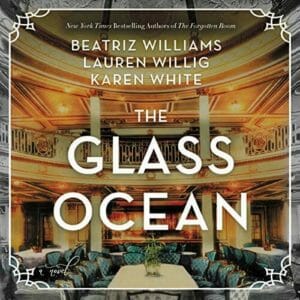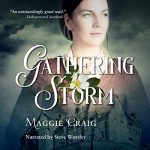 Narrated by Brittany Pressley, Vanessa Johansson and Saskia Maarleveld
Narrated by Brittany Pressley, Vanessa Johansson and Saskia Maarleveld
Three authors, three main characters, three narrators; The Glass Ocean is a dual timeline story from the pens of the 3Ws – Williams, Willig and White – that weaves together interconnecting stories featuring three very different woman in two different time-periods almost a century apart. I have no idea which author penned which character – and apparently it’s a very closely guarded secret – but the narration is clearly assigned, with Vanessa Johansson reading the chapters told by Sarah Blake, and Brittany Pressley and Saska Maarleveld reading those from the points of view of Caroline Hochstetter and Tess Schaff respectively.
Five years earlier, Sarah Blake wrote a very successful book about the mid-nineteenth century Irish Potato Famine. For a year she was feted, interviewed, sought after for book signings and events… but when inspiration for a follow-up book failed to arrive, she more or less fell off the radar, and now, even her agent hardly ever calls her. She’s struggling – both creatively and financially – and in desperation, turns to an old family heirloom, breaking her promise to her Alzheimer-stricken mother and opening the chest that belonged to her great-grandfather, who died when the RMS Lusitania was torpedoed by a German U-Boat in 1915. What she finds there leads her to travel to England to request access to the archives of the Langford family in the hope that the documents contained within it will help her to find answers to the questions raised by her great-grandfather’s papers. The problem is that getting permission to view the Langford family’s documents is going to be difficult. John Langford MP has recently become unwillingly entangled in a scandal involving his ex-wife and is lying low in an attempt to dodge the paparazzi stalking him, so Sarah is going to have to approach him carefully – and probably using subterfuge – if she’s to stand any chance of getting him to agree to her request.
Back in 1915, Southern belle and socialite Caroline Hochstetter is young, beautiful, talented and very much in love with her husband, Gilbert, who has, of late, had very little time for her, and devotes all his time and attention to his work. She is unhappy at his neglect and at the prospect of their upcoming trip across the Atlantic for more than one reason; with England at war with Germany, there’s no guarantee of safety crossing the ocean, and on a more personal level, Gilbert has arranged to sell the manuscript of a very valuable unfinished waltz by the composer Johann Strauss which he gave Caroline as a wedding present. She tries to dissuade him one last time, but he won’t be swayed, attempting to placate her by presenting her with (yet another) piece of gaudy jewellery she doesn’t want to wear.
Also in 1915, Tess Schaff has agreed to pull one last job for her sister before boarding the Lusitania to cross to England and make a new life for herself. She and Ginny spent most of their lives assisting their con-man father in various scams, but Tess has had enough and wants out; once she’s got into the party at the Hochstetter mansion and made a copy (she’s a talented artist and forger) of the manuscript Ginny’s directed her to, she’s walking away. But unfortunately for Tess, when she finally makes her way to Caroline Hochstetter’s empty bedroom – the manuscript isn’t where it’s supposed to be. She’ll have to find it and make the copy once she’s aboard ship.
Also sailing on the Lusitania is Englishman Robert Langford, John Langford’s great-grandfather. Robert has been in love with Caroline for years, and although he knows it’s hopeless, he can’t help taking opportunities to spend time with her and, sensing her unhappiness, to comfort her however he can. In fact, the first time Tess sees Caroline, it’s from the outside of the house, through the window of the music room where she watches her and a man she doesn’t know (Robert) playing a duet at the piano. Tess is immediately struck by the gentleman’s handsome features and the yearning that emanates from him and longs to paint him – something that will never happen.
The story is told in alternating chapters from the points of view of the three women; Sarah’s in first person and Caroline and Tess’s in third. In 2013, Sarah and John delve deeper into the mystery of exactly what happened during the fateful voyage and how their respective relatives were involved in events. At the same time, they’re drawing closer, wary of admitting to the growing attraction between them seeing as Sarah will soon be returning to New York. And in 1915, as Caroline struggles to reconcile her feelings for her husband and for Robert Langford, while Tess starts to have suspicions as to the nature of the job she’s been asked to do, and to realise she’s falling in love with a man she can never have. The authors have put together a very intriguing espionage plotline that runs through the 1915 sections of the story; what exactly is the importance of the Strauss waltz? What is so important that Gilbert neglects his wife, and what is Robert Langford’s importance in all this? Is he a traitor? What is Gilbert hiding? And why is Tess’s sister being so elusive?
The three narrators are all skilled and very experienced, although Saskia Maarleveld is the only one of them I’ve listened to before. All of them are able to sustain decent English accents when portraying John or Robert Langford, although I found that Ms. Johansson was the weakest when it came to portraying male characters in general, as she differentiates mostly by accent and doesn’t adopt a significant change of pitch for John’s dialogue. Most of Sarah’s chapters consist of narrative or interactions with John, and it wasn’t until a chapter towards the end when Sarah has a conversation with another male character – an American – that I noticed that he and Sarah basically sounded the same so I had to rely on the dialogue tags to work out who was speaking. This only happens in that one chapter, fortunately, but the fact that Sarah and John’s voices are in more or less the same register is noticeable throughout.
As Caroline, Brittany Pressley adopts a southern accent that sounded right to my European ears, and I found her portrayal of Gilbert and Robert to sound more convincingly masculine, which was also the case with Ms. Maarleveld’s portions of the narration; I know from having listened to her in the past that she’s very good at portraying male characters, having a naturally low voice that lends itself well to the necessary variation in pitch. In the chapters where Tess and Caroline interact, Ms. Maarleveld does a creditable job with Caroline’s accent, and Ms. Pressley adopts a deeper pitch for Tess, which aligns nicely with Ms. Maarleveld’s portrayal of her.
All three narrators do a great job overall, differentiating well between the various secondary characters, maintaining a good pace and imbuing their performances with appropriate expression and nuance.
I found the story a little slow to start, but once I’d got past the opening few chapters, things started to take off, and I was soon engrossed and listening at every available opportunity. The Glass Ocean is an excellent piece of historical fiction featuring flawed but likeable characters and a well-conceived plot; I’d recommend it to anyone who enjoys their historicals liberally peppered with romance and intrigue.
Caz
Buy The Glass Ocean by Beatriz Williams, Lauren Willig, Karen White on Amazon



